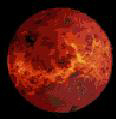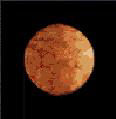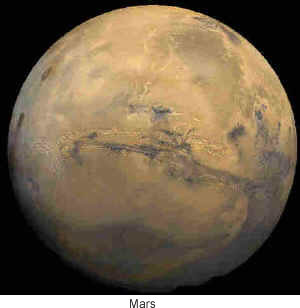BACKGROUND:
The Solar System consists of our Sun (a star) and an
assemblage of smaller bodies that revolve around the Sun. The smaller bodies
include the planets and their moons, asteroids, comets, and interplanetary
dust.
|

Venus
|
The major planets, in order of increasing distance
from the Sun, are Mercury, Venus, Earth, Mars, Jupiter, Saturn, Uranus,
Neptune, and Pluto. Scientists commonly divide these into two groups. The
terrestrial planets (also called inner planets), Mercury, Venus, Earth and
Mars and the gas planets of Jupiter, Saturn, Uranus, and Neptune. Pluto is
considered a terrestrial planet, but not an inner planet.
Moons, or natural satellites, are bodies that revolve
around a planet. The Earth has one moon, while the other planets have none
to many. Moons have varying compositions. The Earthís Moon is essentially
rock. Other moons, particularly those of Jupiter and Saturn, appear to have
rocky cores, but are surrounded by gaseous atmospheres.
Asteroids are small bodies of rock and frozen gas.
They tend to be concentrated in a belt between the orbits of Mars and
Jupiter. Some asteroids also orbit the Sun, on paths that cross the Earthís
orbit. These objects began in the asteroid belt, but were pushed into orbit
around the Sun by the gravitational effects of Jupiter, or collisions with
other asteroids. Meteors or "shooting stars" refers to flashes of
light that dart across the night sky. These occur when an asteroid enters
the Earthís atmosphere and burns up.
|

Mercury
|
A comet is a small body composed of frozen gas and
small amounts of rock. Comets are leftovers from the formation of the Solar
System. Most comets reside in a belt outside the orbit of Pluto., or much
further away in a huge shell surrounding the Solar System. Comets travel
inward toward the Sun, developing elliptical orbits. As a comet approaches
the Sun, solar radiation heats it up. Escaping gas and dust form the cometís
tail.
Mercury is the closest planet to the Sun. It orbits
the Sun quickly, once every 88 days. Because it is so close to the Sun, it
is difficult to see. Mercuryís orbit is very elliptical, ranging from
46-70 million km from the Sun. It rotates slowly once every 59 days. The Sun
appears 2.5 times larger from Mercury than it does from Earth. Surface rocks
facing the Sun roast to 400oC while the long night surface cools to
-170oC.
Mercury is small, about 4850 kilometers (~3000 miles) in diameter. The
surface of Mercury looks like the Moon, but is gray-orange in color. There
are many impact craters and large areas of lava, like the Moon's large
plains.
Venus the second planet away from the Sun, is Earthís
closest neighbor. It is about the same size as the Earth, a little over
12,000 kilometers (7300 miles) in diameter. It is sometimes considered to be
the Earthís twin. Venus rotates counterclockwise once every 242 days. This
is opposite to all the all other planets. Venus has a very thick atmosphere,
composed largely of sulphuric acid and CO2. The surface
temperature of Venus has been recorded as high as 475oC, which is hotter
than Mercury. This is because of the greehouse effect of Venusís
atmosphere. The clouds within the atmosphere trap heat, raising the surface
temperature. The surface of Venus is covered with craters, volcanoes, and
large ridges which may be evidence of mountain building.
 Mars has a diameter of 6790 km, just over half of the
Earth. It takes Mars 687 days to revolve once around the Sun. Its orbit is
elliptical, ranging from 206-249 million km in diameter. The surface of Mars
has an intense reddish orange hue, which is caused by large amounts of iron
oxide in rocks. Mars has a very thin atmosphere, which is composed largely
of CO2. Its surface is very cold, and is covered with craters,
volcanoes, and large canyons, which may indicate the past presence of water.
Maximum surface temperatures range from -29oC to -100oC. Mars has two tiny
satellites called Phobos and Deimos. Phobos is fast; it travels 3 times
around Mars in one day!
Mars has a diameter of 6790 km, just over half of the
Earth. It takes Mars 687 days to revolve once around the Sun. Its orbit is
elliptical, ranging from 206-249 million km in diameter. The surface of Mars
has an intense reddish orange hue, which is caused by large amounts of iron
oxide in rocks. Mars has a very thin atmosphere, which is composed largely
of CO2. Its surface is very cold, and is covered with craters,
volcanoes, and large canyons, which may indicate the past presence of water.
Maximum surface temperatures range from -29oC to -100oC. Mars has two tiny
satellites called Phobos and Deimos. Phobos is fast; it travels 3 times
around Mars in one day!
PROCEDURE:
- In this exercise, the students will construct a model of the orbits
inner or terrestrial planets. First, go over some of the information on
the terrestrial planets, making sure students are able to compare and
contrast the different planets.
- Have the students use compasses to make the appropriate sized circles
for each orbit. If you do not have compasses, you can either make
circles that act as templates before the exercise or use two pencils
tied together with a string measured at the appropriate distance.
Use the following ratio for the orbits: Sun: Mercury: Venus: Earth:
Mars = 0: 1: 2: 3 1/2: 4 1/2. For example, if you are using the metric
system, the Sun would be 0 cm. Mercury's orbit would be 10 cm in
diameter, Venus' orbit is 20 cm, Earth's orbit is 35 cm and Mars' orbit
would be 45 cm. If your paper is not large enough for these dimensions,
cut the diameter of each of the planets by half.
Have the students cut out the orbits.
- Have the students push a brad through a sheet of paper. This will
represent the Sun. Stack the orbits on the brad, starting with the
largest orbit (Mars), then Earth, followed by Venus, and finally
Mercury.
- Have the students revolve each disk in the correct direction, using
the chart on the worksheet for guidance. All four planets should revolve
counterclockwise.
- Remind the students that the orbits of the planets are not circular,
but have elliptical shapes, as shown on the Orbits of the Planets
picture (from the Pre Lab). Have the students compare this with the
Solar System Placemat. It is a closer look at the planets.